8. Light
The Moon a Luminous Object:
- The moon provides light as well, but it cannot produce light by its own.
- The light emitted by the Moon is the light of the Sun reflected towards the Earth.
- When we see the Moon, we see only the Moon’s lighted part.
- Thus, half of the moon is always facing the Sun and receiving light from it.
- Hence, we receive light from the moon.
Ambulance:
- This is due to lateral inversion.
- The phenomenon due to which the left side of an object appears to be right side of the object in its image in a reflecting medium (mirror).
- So that drivers see the word the right way around in their rear-view mirror.
Danger Lights in vehicles are red in colour:
- Red color is scattered the least by air molecules.
- Red color has the highest wavelength of all the other colors.
- So red color is able to travel the longest distance through air, fog.
Periscope Works:
- It is an instrument used for viewing bodies or ships, which are over and around another body or a submarine.
- It is based on the principle of the law of reflection of light.
- It consists of a long outer case and inside this case mirrors or prisms are kept at each end, inclined at an angle of 45°.
- Light coming from the distant body, falls on the mirror at the top end of the periscope and gets reflected vertically downward.
- This light is reflected again by the second mirror kept at the bottom, so as to travel horizontally and reach the eye of the observer.
- In some complex periscopes, optic fibre is used instead of mirrors for obtaining a higher resolution.
- The distance between the mirrors varies depending on the purpose.
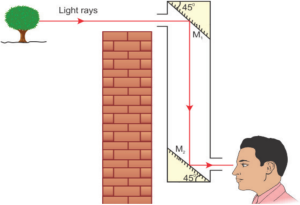
Uses:
- It is used in warfare and navigation of the submarine.
- In military it is used for pointing and firing guns from a ‘bunker’.
- Photographs of important places can be taken through periscopes without trespassing restricted military regions.
- Fiber optic periscopes are used by doctors as endoscopes to view internal organs of the body.
Total Internal Resonance:
- When light travels from denser medium into a rarer medium, it gets refracted away from the normal.
- While the angle of incidence in the denser medium increases the angle of refraction also increases and it reaches a maximum value of r = 90º for a particular value.
- This angle of incidence is called critical angle.
- The angle of incidence at which the angle of refraction is 90º is called the critical angle.
- At this angle, the refracted ray grazes the surface of separation between the two media.
- When the angle of incidence exceeds the value of critical angle, the refracted ray is not possible.
- Since r > 90º the ray is totally reflected back to the same medium.
- This is called as total internal reflection.
Conditions to achieve total internal reflection:
- In order to achieve total internal reflection the following conditions must be met.
- Light must travel from denser medium to rarer medium. (Example: From water to air).
- The angle of incidence inside the denser medium must be greater than that of the critical angle.
Total internal reflection in nature:
Mirage:
- On hot summer days, patch of water may be on the road.
- This is an illusion. In summer, the air near the ground becomes hotter than the air at higher levels.
- Hotter air is less dense, and has smaller refractive index than the cooler air.
- Thus, a ray of light bends away from the normal and undergoes total internal reflection.
- Total internal reflection is the main cause for the spectacular brilliance of diamonds and twinkling of stars.
Optical fibres:
- Optical fibres are bundles of high-quality composite glass/quartz fibres.
- Each fibre consists of a core and cladding.
- The refractive index of the material of the core is higher than that of the cladding.
- Optical fibres work on the phenomenon of total internal reflection.
- When a signal in the form of light is directed at one end of the fibre at a suitable angle, it undergoes repeated total internal reflection along the length of the fibre and finally comes out at the other end.
- Optical fibres are extensively used for transmitting audio and video signals through long distances.
- Moreover, due to their flexible nature, optical fibers enable physicians to look and work inside the body through tiny incisions without having to perform surgery.
Effects due to total internal reflection:
Glittering of diamond:
- Diamond appears dazzling because the total internal reflection of light happens inside the diamond.
- The refractive index of only diamond is about 2.417.
- It is much larger than that for ordinary glass which is about only 1.5.
- The critical angle of diamond is about 24.4°.
- It is much less than that of glass.
- A skilled diamond cutter makes use of this larger range of angle of incidence (24.4° to 90° inside the diamond), to ensure that light entering the diamond is total internally reflected from the many cut faces before getting out.
- This gives a sparkling effect for diamond.
Mirage and looming:
- The refractive index of air increases with its density.
- In hot places, air near the ground is hotter than air at a height.
- Hot air is less dense. Hence, in still air the refractive index of air increases with height.
- Because of this, light from tall objects like a tree, passes through a medium whose refractive index decreases towards the ground.
- Hence, a ray of light successively deviates away from the normal at different layers of air and undergoes total internal reflection when the angle of incidence near the ground exceeds the critical angle.
- This gives an illusion as if the light comes from somewhere below the ground.
- For of the shaky nature of the layers of air, the observer feels as if the object is getting reflected by a pool of water or wet surface beneath the object.
- This phenomenon is called mirage.
- In the cold places the refractive index increases towards the ground because the temperature of air close to the ground is lesser than the temperature above the surface of earth.
- Thus, the density and refractive index of air near the ground is greater than at a height.
- In the cold regions like glaciers and frozen lakes and seas, the reverse effect of mirage will happen.
- Hence, an inverted image is formed little above the surface.
- This phenomenon is called looming.
Radius of illumination (Snell’s window):
- When a light source like electric bulb is kept inside a water tank, the light from the source travels in all direction inside the water.
- The light that is incident on the water surface at an angle less than the critical angle will undergo refraction and emerge out from the water.
- The light incident at an angle greater than critical angle will undergo total internal reflection.
- The light falling particularly at critical angle graces the surface.
- Thus, the entire surface of water appears illuminated when seen from outside.
- On the other hand, when light entering the water from outside is seen from inside the water, the view is restricted to a particular angle equal to the critical angle ic.
- The restricted illuminated circular area is called Snell’s window.
- The angle of view for water animals is restricted to twice the critical angle 2ic.
- The critical angle for water is 48.6o.
- Thus, the angle of view is 97.2o.
- The radius R of the circular area depends on the depth d from which it is seen and also the refractive indices of the media.
- The radius of Snell’s window can be deduced with the illustration.
- Light is seen from a point A at a depth d.
- The Snell’s law in product form, for the refraction happening at the point B on the boundary between the two media is,

Rayleigh’s scattering law:
- Rayleigh’s scattering law states that, “The amount of scattering of light is inversely proportional to the fourth power of its wavelength”.
Amount of scattering ‘S’ ∝ 1 / λ4
- According to this law, the shorter wavelength colours are scattered much more than the longer wavelength colours.
- When sunlight passes through the atmosphere, the blue colour (shorter wavelength) is scattered to a greater extent than the red colour (longer wavelength).
- This scattering causes the sky to appear in blue colour.
- At sunrise and sunset, the light rays from the Sun have to travel a larger distance in the atmosphere than at noon.
- Hence, most of the blue lights are scattered away and only the red light which gets least scattered reaches us.
- Therefore, the colour of the Sun is red at sunrise and sunset.
Mie scattering:
- Mie scattering takes place when the diameter of the scatterer is similar to or larger than the wavelength of the incident light.
- It is also an elastic scattering.
- The amount of scattering is independent of wave length.
- Mie scattering is caused by pollen, dust, smoke, water droplets, and other particles in the lower portion of the atmosphere.
- Mie scattering is responsible for the white appearance of the clouds.
- When white light falls on the water drop, all the colours are equally scattered which together form the white light.
Tyndall Scattering:
- When a beam of sunlight, enters into a dusty room through a window, then its path becomes visible to us.
- This is because, the tiny dust particles present in the air of the room scatter the beam of light.
- This is an example of Tyndall Scattering
- The scattering of light rays by the colloidal particles in the colloidal solution is called Tyndall Scattering or Tyndall Effect.
Raman Effect:
- When a parallel beam of monochromatic (single coloured) light passes through a gas or liquid or transparent solid, a part of light rays are scattered.
- The scattered light contains some additional frequencies (or wavelengths) other than that of incident frequency (or wavelength).
- This is known as Raman scattering or Raman Effect.
- Raman Scattering is defined as “The interaction of light ray with the particles of pure liquids or transparent solids, which leads to a change in wavelength or frequency.”
- The spectral lines having frequency equal to the incident ray frequency is called ‘Rayleigh line’ and the spectral lines which are having frequencies other than the incident ray frequency are called ‘Raman lines’.
- The lines having frequencies lower than the incident frequency is called stokes lines and the lines having frequencies higher than the incident frequency are called Antistokes lines.
Function and defects of the human eye:
- The human eyes are most valuable and sensitive organs responsible for vision.
- They are the gateway to the wonderful world.
Structure of the eye:
- The eye ball is approximately spherical in shape with a diameter of about 2.3 cm.
- It consists of a tough membrane called sclera, which protects the internal parts of the eye.
Important parts of human eye are
- Cornea:
- This is the thin and transparent layer on the front surface of the eyeball.
- It is the main refracting surface.
- When light enters through the cornea, it refracts or bends the light on to the lens.
- Iris:
- It is the coloured part of the eye.
- It may be blue, brown or green in colour.
- Every person has a unique colour, pattern and texture.
- Iris controls amount of light entering into the pupil like camera aperture.
- Pupil:
- It is the centre part of the Iris.
- It is the pathway for the light to retina.
- Retina:
- This is the back surface of the eye.
- It is the most sensitive part of human eye, on which real and inverted image of objects is formed.
- Eye Lens
- It is the important part of human eye.
- It is convex in nature.
- Ciliary muscles
- Eye lens is fixed between the ciliary muscles.
- It helps to change the focal length of the eye lens according to the position of the object.
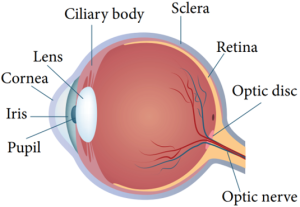
Working of the eye:
- The transparent layer cornea bends the light rays through pupil located at the centre part of the Iris.
- The adjusted light passes through the eye lens.
- Eye lens is convex in nature.
- So, the light rays from the objects are converged and a real and inverted image is formed on retina.
- Then, retina passes the received real and inverted image to the brain through optical nerves.
- Finally, the brain senses it as erect image.
Power of Accommodation:
- The ability of the eye lens to focus nearby as well as the distant objects is called power of accommodation of the eye.
- This is achieved by changing the focal length of the eye lens with the help of ciliary muscles.
- Eye lens is made of a flexible, jelly-like material.
- By relaxing and contracting the ciliary muscle, the curvature and hence the focal length of the eye lens can be altered.
- When we see distant objects, the ciliary muscle relaxes and makes the eye lens thinner.
- This increases the focal length of the eye lens.
- Hence, the distant object can be clearly seen.
- On the other hand, when we look at a closer object, the focal length of the eye lens is decreased by the contraction of ciliary muscle.
- Thus, the image of the closer object is clearly formed on the retina.
Persistence of vision:
- If the time interval between two consecutive light pulses is less than 1 / 16 second, human eye cannot distinguish them separately.
- It is called persistence of vision.
The far point and near point of the human eye:
- The minimum distance required to see the objects distinctly without strain is called least distance of distinct vision.
- It is called as near point of eye.
- It is 25 cm for normal human eye.
- The maximum distance up to which the eye can see objects clearly is called as far point of the eye.
- It is infinity for normal eye.
Defects in Eye:
- A normal human eye can clearly see all the objects placed between 25cm and infinity.
- But, for some people, the eye loses its power of accommodation.
- This could happen due to many reasons including ageing.
- Hence, their vision becomes defective.
- Let us discuss some of the common defects of human eye.
Myopia:
- Myopia, also known as short sightedness, occurs due to the lengthening of eye ball.
- With this defect, nearby objects can be seen clearly but distant objects cannot be seen clearly.
- The focal length of eye lens is reduced or the distance between eye lens and retina increases.
- Hence, the far point will not be infinity for such eyes and the far point has come closer.
- Due to this, the image of distant objects are formed before the retina.
- This defect can be corrected using a concave lens.
- The focal length of the concave lens to be used is computed as follows:
Vision with myopia:
- Corrected vision using a concave lens
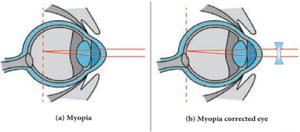
- Let a person with myopia eye can see up to a distance x.
- Suppose that he wants to see all objects farther than this distance, i.e., up to infinity.
- Then the focal length of the required concave lens is f = –x.
- If the person can see up to a distance x and if he wishes to see up to a distance y, then, the focal length of the required concave lens is,

Hypermeteropia:
- Hypermeteropia, also known as long sightedness, occurs due to the shortening of eye ball.
- With this defect, distant objects can be seen clearly but nearby objects cannot be seen clearly.
- The focal length of eye lens is increased or the distance between eye lens and retina decreases.
- Hence, the near point will not be at 25cm for such eyes and the near point has moved farther.
- Due to this, the image of nearby objects are formed behind the retina.
- This defect can be corrected using a convex lens.
- The focal length of the convex lens to be used is computed as follows:
Vision with hypermeteropia:
- Corrected vision using a convex lens
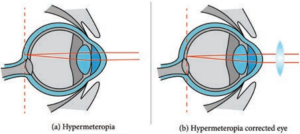
- Let a person with hypermeteropia eye can see object beyond a distance d.
- Suppose that he wants to see all objects closer than this distance up to a distance D.
- Then, the focal length of the required convex lens is

Presbyopia:
- Due to ageing, ciliary muscles become weak and the eye-lens become rigid (inflexible) and so the eye loses its power of accommodation.
- Because of this, an aged person cannot see the nearby objects clearly.
- So, it is also called as ‘old age hypermetropia’.
- Some persons may have both the defects of vision – myopia as well as hypermetropia.
- This can be corrected by ‘bifocal lenses’.
- In which, upper part consists of concave lens (to correct myopia) used for distant vision and the lower part consists of convex lens (to correct hypermetropia) used for reading purposes.
Astigmatism:
- In this defect, eye cannot see parallel and horizontal lines clearly.
- It may be inherited or acquired.
- It is due to the imperfect structure of eye lens because of the development of cataract on the lens, ulceration of cornea, injury to the refracting surfaces, etc.
- Astigmatism can be corrected by using cylindrical lenses.
Telescopes:
- Have you seen the recent lunar eclipse? With our naked eye we can’t visualize the phenomena distinctly. Then, how can we see the distant object in clearer manner? It is possible with telescope.
- Telescope is an optical instrument to see the distant objects.
- The first telescope was invented by Johann Lippershey in 1608.
- Galileo made a telescope to observe distant stars.
- He got the idea, from a spectacle maker who one day observed that the distant weather cock appeared magnified through his lens system fitted in his shop.
- Galileo observed the satellites of Jupiter and the rings of Saturn through his telescope.
- Kepler invented Telescope in 1611 which was fundamentally similar to the astronomical telescope.
Types of Telescope:
- According to optical property, it is classified into two groups:
- Refracting telescope
- Reflecting telescope
- In refracting telescope lenses are used.
- Galilean telescope, Keplerian telescope, Achromatic refractors, are some refracting telescopes.
- In reflecting telescope parabolic mirrors are used Gregorian, Newtonian, Cassegrain telescope are some Reflecting telescopes.
- According to the things which are observed, Astronomical Telescope and Terrestrial Telescopes are the two major types of telescope.
Astronomical Telescope:
- An astronomical telescope is used to view heavenly bodies like stars, planets galaxies and satellites.
Terrestrial Telescopes:
- The image in an astronomical telescope is inverted.
- So, it is not suitable for viewing objects on the surface of the Earth.
- Therefore, a terrestrial telescope is used.
- It provides an erect image.
- The major difference between astronomical and terrestrial telescope is erecting the final image with respect to the object.
Advantages of Telescopes:
- Elaborate view of the Galaxies, Planets, stars and other heavenly bodies is possible.
- Camera can be attached for taking photograph for the celestial objects.
- Telescope can be viewed even with the low intensity of light.
Disadvantages:
- Frequent maintenances needed.
- It is not easily portable one.
Optical Fibre:
- Transmitting signals through optical fibres is possible due to the phenomenon of total internal reflection.
- Optical fibres consists of inner part called core and outer part called cladding (or) sleeving.
- The refractive index of the material of the core must be higher than that of the cladding for total internal reflection to happen.
- Signal in the form of light is made to incident inside the core-cladding boundary at an angle greater than the critical angle.
- Hence, it undergoes repeated total internal reflections along the length of the fibre without undergoing any refraction.
- The light travels inside the core with no appreciable loss in the intensity of the light.
- Even while bending the optic fiber, it is done in such a way that the condition for total internal reflection is ensured at every reflection.
- An endoscope is an instrument used by doctors which has a bundle of optical fibres that are used to see inside a patient’s body.
- Endoscopes work on the phenomenon of total internal reflection.
- The optical fibres are inserted in to the body through mouth, nose or a special hole made in the body.
- Even operations could be carried out with the endoscope cable which has the necessary instruments attached at their ends.
- Rainbow is an example of dispersion of sunlight through droplets of water during rainy days.
- Rainbow is observed during a rainfall or after the rainfall or when we look at a water fountain provided the sun is at the back of the observer.
- When sunlight falls on the water drop suspended in air, it splits (or dispersed) into its constituent seven colours.
- Thus, water drop suspended in air behaves as a glass prism.
- Primary rainbow is formed when light entering the drop undergoes one total internal reflection inside the drop before coming out from the drop.
- The angle of view for violet to red in primary rainbow is 40o to 42o.
- A secondary rainbow appears outside of a primary rainbow and develops when light entering a raindrop undergoes two internal reflections.
- The angle of view for red to violet in a secondary rainbow is, 52o to 54o.
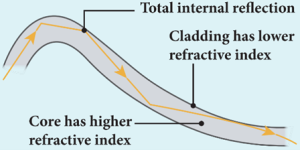
- When sunlight enters the atmosphere of the earth, the atmospheric particles present in the atmosphere change the direction of the light.
- This process is known as scattering of light.
- If the scattering of light is by atoms and molecules which have size a very less than that of the wave length λ of light a<<λ, the scattering is called Rayleigh’s scattering.
- The intensity of Rayleigh’s scattering is inversely proportional to fourth power of wavelength.

- According to equation 6.114, violet colour which has the shortest wavelength gets much scattered during day time.
- The next scattered colour is blue.
- As our eyes are more sensitive to blue colour than violet colour the sky appears blue during day time.
- But, during sunrise and sunset, the light from sun travels a greater distance through the atmosphere.
- Hence, the blue light which has shorter wavelength is scattered away and the less-scattered red light of longer wavelength manages to reach our eye.
- This is the reason for the reddish appearance of sky during sunrise and sunset.
- If light is scattered by large particles like dust and water droplets present in the atmosphere which have size a greater than the wavelength λ of light, a >> λ, the intensity of scattering is equal for all the wavelengths.
- It is happening in clouds which contains large amount of dust and water droplets.
- Thus, in clouds all the colours get equally scattered irrespective of wavelength.
- This is the reason for the whitish appearance of cloud.
- But, the rain clouds appear dark because of the condensation of water droplets on dust particles that makes the cloud become opaque.
- If earth has no atmosphere there would not have been any scattering and the sky would appear dark.
- That is why sky appears dark for the astronauts who could see the sky from above the atmosphere.
Atmospheric refraction:
- Due to refraction of light through different layers of atmosphere which vary in refractive index, the path of light deviates continuously when it passes through atmosphere.
- For example, the Sun is visible a little before the actual sunrise and also until a little after the actual sunset due to refraction of light through the atmosphere.
- By actual sunrise what we mean is the actual crossing of the sun at the horizon.
- The apparent shift in the direction of the sun is around half a degree and the corresponding time difference between actual and apparent positions is about 2 minutes.
- Sun appears flattened (oval shaped) during sun rise and sunset due to the same phenomenon.
- The stars actually do not twinkle.
- They appear twinkling because of the movement of the atmospheric layers with varying refractive indices which is clearly seen in the night sky.
Photoelectric Cell:
Photo Cell:
- Photo electric cell or photo cell is a device which converts light energy into electrical energy.
- It works on the principle of photo electric effect.
- When light is incident on the photosensitive materials, their electric properties will get affected, based on which photo cells are classified into three types. They are:
- Photo emissive cell: Its working depends on the electron emission from a metal cathode due to irradiation of light or other radiations.
- Photo voltaic cell: Here sensitive element made of semiconductor is used which generates voltage proportional to the intensity of light or other radiations.
- Photo conductive cell: In this, the resistance of the semiconductor changes in accordance with the radiant energy incident on it.
Photo Emissive Cell:
Construction:
- It consists of an evacuated glass or quartz bulb in which two metallic electrodes – that is, a cathode and an anode are fixed.
- The cathode C is semi-cylindrical in shape and is coated with a photo sensitive material.
- The anode A is a thin rod or wire kept along the axis of the semi-cylindrical cathode.
- A potential difference is applied between the anode and the cathode through a galvanometer G.
Working:
- When cathode is illuminated, electrons are emitted from it.
- These electrons are attracted by anode and hence a current is produced which is measured by the galvanometer.
- For a given cathode, the magnitude of the current depends on
- The intensity to incident radiation and
- The potential difference between anode and cathode.
Applications of photo cells:
- Photo cells have many applications, especially as switches and sensors.
- Automatic lights that turn on when it gets dark use photocells, as well as street lights that switch on and off according to whether it is night or day.
- Photo cells are used for reproduction of sound in motion pictures and are used as timers to measure the speeds of athletes during a race.
- Photo cells of exposure meters in photography are used to measure the intensity of the given light and to calculate the exact time of exposure.
Uses of X-Ray:
- X-rays are being used in many fields.
- Let us list a few of them.
Medical diagnosis:
- X-rays can pass through flesh more easily than through bones.
- Thus an x-ray radiograph containing a deep shadow of the bones and a light shadow of the flesh may be obtained.
- X-ray radiographs are used to detect fractures, foreign bodies, diseased organs etc.
Medical therapy:
- Since x-rays can kill diseased tissues, they are employed to cure skin diseases, malignant tumours etc.
Industry:
- X-rays are used to check for flaws in welded joints, motor tyres, tennis balls and wood.
- At the custom post, they are used for detection of contraband goods.
Scientific research:
- X-ray diffraction is important tool to study the structure of the crystalline materials – that is, the arrangement of atoms and molecules in crystals.
The height of the mirror needed to see the image of a person fully on the mirror:
- Let us assume a person of height h is standing in front of a vertical plane mirror.
- The person could see his/her head when light from the head falls on the mirror and gets reflected to the eyes.
- Same way, light from the feet falls on the mirror and gets reflected to the eyes.
- If the distance between his head H and eye E is h1 and distance between his feet F and eye E is h2.
- The person’s total height h is, h = h1 + h2
- By the law of reflection, the angle of incidence and angle of reflection are the same in the two extreme reflections.
- The normals are now the bisectors of angles between incident and reflected rays in the two reflections.
- By geometry, the height of the mirror needed is only half of the height of the person.
Two-Way Mirror:
- Production of optical surfaces capable of refracting as well as reflecting is possible by properly coating the surfaces with suitable materials.
- Thus, a glass can be made partially see through and partially reflecting by varying the amount of coating on its surface.
- It is commercially called as two way mirror, half-silvered or semi-silvered mirror etc.
- This gives a perception of regular mirror if the other side is made dark.
- But, still hidden cameras can be kept behind such mirrors.
- We need to be cautious when we stand in front of mirrors kept in unknown places.
- There is a method to test the two way mirror.
- Place the finger nail against the mirror surface.
- If there is a gap between nail and its image, then it is a regular mirror.
- If the fingernail directly touches its image, then it is a two way mirror.
Rainbows Appear:
- Rainbow is an example of dispersion of sunlight through droplets of water during rainy days.
- Rainbow is observed during a rainfall or after the rainfall or when we look at a water fountain provided the sun is at the back of the observer.
- When sunlight falls on the water drop suspended in air, it splits (or dispersed) into its constituent seven colours.
- Thus, water drop suspended in air behaves as a glass prism.
- Primary rainbow is formed when light entering the drop undergoes one total internal reflection inside the drop before coming out from the drop as shown in figure.
- The angle of view for violet to red in primary rainbow is 40 o to 42 o.
- A secondary rainbow appears outside of a primary rainbow and develops when light entering a raindrop undergoes two internal reflections.
- The angle of view for red to violet in a secondary rainbow is, 52o to 54o.
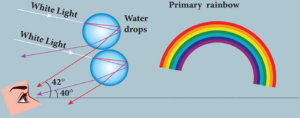
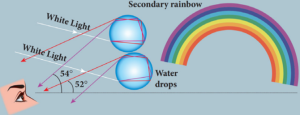
Problems:
- Find the size, nature and position of the image formed when an object of size 1 cm is placed at a distance of 15 cm from a concave mirror of focal length 10 cm.
Solution:
Object distance, u = –15 cm (to the left of mirror)
Image distance, v =?
Focal length, f = –10 cm (concave mirror)
Using mirror formula,

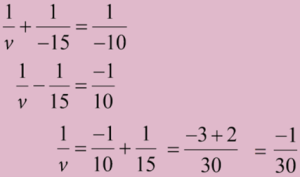
Thus, image distance, v = –30 cm (negative sign indicates that the image is on the left side of the mirror).
∴ Position of image is 30 cm in front of the mirror. Since the image is in front of the mirror, it is real and inverted.
To find the size of the image, we have to calculate the magnification.

We know that, m = h2 / h1
Here, height of the object h1 = 1 cm
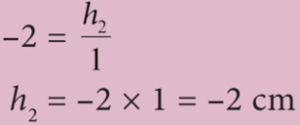
The height of image is 2 cm (negative sign shows that the image is formed below the principal axis).
- A car is fitted with a convex mirror of focal length 20 cm. Another car is 6 m away from the first car. Find the position of the second car as seen in the mirror of the first. What is the size of the image if the second car is 2 m broad and 1.6 m high?
Solution:
Focal length = 20 cm (convex mirror)
Object distance = –6m = –600 cm
Image distance v =?


![]()

Size of the image:
![]()
Breadth of image = 1 / 31 × 200 cm = 6.45 cm
Height of image = 1 / 31 × 160 cm = 5.16 cm
